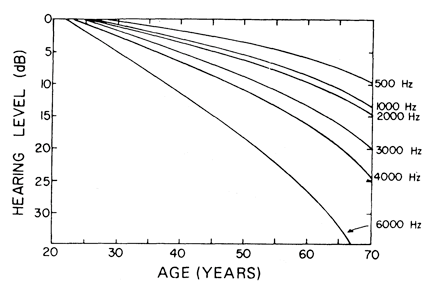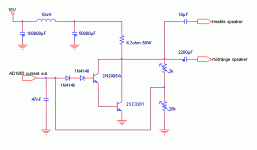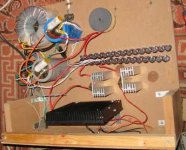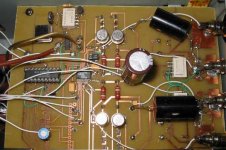No, they are 'realists' who have to compete with other companies. Never stick your head up too far! '-)
Just a comment about what DAC vendors believe constitutes sufficient performance. The AD1865 DAC chip is usually used in current output mode, but it also contains an on-board I/V op-amp. The Analog Devices datasheet takes the time to specifically mention that this on-board op-amp was designed to handle the high slew rates it would be subjected to, even at an x16 oversampling rate. They even go as far as to mention that this internal op-amp features an all NPN output stage.
Now, AD knows as much about high-performance op-amp design as anyone. So, after experimenting with the AD1865, non-oversampled, in both it's current (simple resistor i/v), and voltage output modes (internal op-amp), I can report that, sonically, there's no comparison. The current output mode via simple resistor i/v is so much more transparent, you'd think that you were listening to two entirely different converter chips.
That is nice, so there are ways to do things just better without opamps. So why are some trying very hard to persevere that opamps are the best for this purpose ?
To me, newer OpAmps like the AD8099 or LM4562 are plenty sufficient for the today DAC's I/V stages. DAC manufacturers agree also with that.
Which vendors offer I/V with LM4562? I'd like to have a laugh... 😀
well thats good Ken, you can report there is no comparison (which is good, because i dont see one)..and after so much experimentation as well?....well we all better throw in the towel and concede that worse is actually better (re transparency)
yeah its kinda funny, i've often wondered why the dac chips (themselves integrated circuits that use feedback) are usually good enough for the pundits as a dac, but when it comes to making them output the analogue portion of the DAC, all of a sudden the designers are a bunch of penny pinching fools who wouldnt know what to do with their own design when all along they could just use a pair of resistors for more transparent results
when all along they could just use a pair of resistors for more transparent results
yeah its kinda funny, i've often wondered why the dac chips (themselves integrated circuits that use feedback) are usually good enough for the pundits as a dac, but when it comes to making them output the analogue portion of the DAC, all of a sudden the designers are a bunch of penny pinching fools who wouldnt know what to do with their own design
 when all along they could just use a pair of resistors for more transparent results
when all along they could just use a pair of resistors for more transparent results
Last edited:
Yep, AD engineers are a bunch of monkeys. They got the plans for their 1990 DAC from martians and they just slapped a stinky OpAmp inside.
That by the way was absolutelly appropiate for the 16 bit signals of the era.
The use external OpAmps AD797 in the datasheet of their today flagship AD1955 is just another conspiration...
I do believe that you've missed my point.
That is nice, so there are ways to do things just better without opamps. So why are some trying very hard to persevere that opamps are the best for this purpose ?
Only they can say for sure, but my guess is that it's for the following reasons:
1. Op-amp I/V is easier to implement with DACs that require something very close to a virtual A.C. ground for best performance, which is to say nearly all of them. The output protection diodes of many DAC chips forces this constraint. Implementing such a virtual ground without op-amps (and their requisite feedback loop) pretty much requires a discrete solid-state grounded base/gate I/V circuit, or a very high-gain (probably two stage) open-loop tube circuit which could be relatively quite costly.
2. Objective measurements say that op-amp I//V has the lowest static THD. By that measure, however, we would all be purchasing only high-feedback solid-state amplification components. The trouble with this view, of course, is that our ears often disagree with what spectrum analyzers say. If only we listened to music through a spectrum analyzer it would be simple to identify the best components or circuit implementations. Music appreciation is a human quality. Audio egineering should be in service of that appreciation, not the dictator of it.
3. Commodity DAC boxes are simply too easy to design, what with the few VLSI integrated circuits required anybody can "design" a DAC box. Which isn't to say that they necessarily know what they are doing. Even if they do hear deficiencies in their finished design do they know what to do to minimize those deficiencies? The great thing about op-amps is that they are so accessible for audio electronics neophytes, and convenient for the experts. The problem with op-amps is that their use is seldom optimized by such neophytes, let alone the question of whether some discrete implementation would provide better perceived performance, let further alone the question of how to deign such an discrete circuit. Even many expert engineers, IMO, get seduced by the convenience leaving the DAc analog stage implementation appearing to be almost an afterthought income cases, something not surprising given the time and cost pressures of producing a commercial product.
4. The cost. Most other implementation of an I/V plus output buffer will be more costly to design and produce than with op-amps.
Last edited:
well thats good Ken, you can report there is no comparison (which is good, because i dont see one)..and after so much experimentation as well?....well we all better throw in the towel and concede that worse is actually better (re transparency)
yeah its kinda funny, i've often wondered why the dac chips (themselves integrated circuits that use feedback) are usually good enough for the pundits as a dac, but when it comes to making them output the analogue portion of the DAC, all of a sudden the designers are a bunch of penny pinching fools who wouldnt know what to do with their own designwhen all along they could just use a pair of resistors for more transparent results
Firstly, please spare me your silly condecensions.
Secondly, hyperbole much?
You sound like the kind of person who let's spectrum analyzes tell them to what degree their ears should be enjoying the music being reproduced some given component. Better yet, just visit eBay and order whatever are the cheapest components claiming the lowest static THD, yes?
Regarding DAC chip design, the resistor class of DACs (R-2R, ladder, etc.) don't use signal feedback. They typically consist of a quiet precision buffered voltage reference feeding resistors, or switch precision current sources through those resistors. You will see feedback employed to maintain D.C. levels, or to minimize the output impedance of the reference buffer. If, however, they employed signal feedback at the quantizer block you'd see much better THD figures listed for the resistor class of DACs, which greatly depend on the precision of their resistor networks (or on averaging the lack of precision to noise via DEM) for low distortion (particularly obvious problem at low signal levels), just as you see low THD figures for the feedback based sigma-delta types. The sigma-delta class of DACs inherently use discrete-time digital feedback, which is not the thing thing as the actual quantizer block which can and often is a small multibit resistor class converter.
Last edited:
Yep, AD engineers are a bunch of monkeys. They got the plans for their 1990 DAC from martians and they just slapped a stinky OpAmp inside.
That by the way was absolutelly appropiate for the 16 bit signals of the era.
The use external OpAmps AD797 in the datasheet of their today flagship AD1955 is just another conspiration...
"They got the plans for their 1990 DAC from martians and they just slapped a stinky OpAmp inside."
I don't understand this statement exactly.
In the case, that you think, this topology is bad for good acoustical sonic performance - what would be a better solution for the AD1955 output filter (I have heard, that at the output of AD1955 isn't a R2R network like by PCM1704/1702/63) ??
From a death link from France - main page go to
Vincent Brient
I have save this text and attachments:
A Power DAC (simple two-way I/U converter for AD1955)
This is a hifi design using a minimum of components in the signal path. A DAC AD1955 is used and the current to voltage converter will be the power part. So I modified a CD player and made a DAC board equipped with the AD1955:
and used and external case for the power part. It uses a class A current to voltage converter able to deliver 1W per channel, enough for horns. A PIC decodes the the infra-red commands and ajustes the digital volume in the AD1955:
Analog Device recommands a 2.5V voltage at each AD1955 current output. Two 1N4148 diodes and two transistor bases make this voltage. The feedback is ajustable and set the bias current and the gain. The high frequencies are naturally filtered by the limited bandwith. A PI filter has been necessary to get a perfectly silent amplifier.
Use: I am using this amplifier from 120Hz only, a conventional active crossover and amplifier are used to get a higher power output for bass.
What about this solution?
Attachments
Last edited:
It is fun to read this thread. Discussion about using transformers, which topology to use in opamps, feedback versus no feedback, using only resistors..
All this let mé think where does the logical thinking goes!? Before advocating for a design type or material use, maybe it would in place to analyse how the current ouput is designed and it does not differ a lot from manufacture to manufacture.
Look at things Like why does the chip bias at +2.5v?
What is the worst condition the output Will swing?
How do we get maximum linearity?
I try not to be biased regarding circuit thinking as i Think let you get the Best solution in the end...
- Sonny
All this let mé think where does the logical thinking goes!? Before advocating for a design type or material use, maybe it would in place to analyse how the current ouput is designed and it does not differ a lot from manufacture to manufacture.
Look at things Like why does the chip bias at +2.5v?
What is the worst condition the output Will swing?
How do we get maximum linearity?
I try not to be biased regarding circuit thinking as i Think let you get the Best solution in the end...
- Sonny
The fact it is that a transformer is NOT a LF filter. Is a pass-band complex filter, imposible to adjust and on top of that with neliniarity issues. The worse is that it has an input resistance/impedance that is higher than the one necessary to be seen at the DAC current outputs.
The DC resistance of a transformer is extremely small, depending on the number of turns and the thickness of the wire. The impedance is a function of turns, turns ratio, and loading resistor. The performance of high quality transformers is extremely good in my opinion.
@dirkwright - the load resistance in secondary will reflect in primary via (Np/Ns)^2! So your "filter" will be load dependent!
How do you plan to "calculate" the exact frequency and keep it consistent between different transformers, different amplifiers and even different interconnect cables (that will add transversal capacitance on load)?

@ tiefbassuebertr - I was sarcastic. You call that garbage schematics "proper use of an DAC?" That rats nest with forced 2.5V in DAC output and 20k pot for I/V conversion?
So... based on those schematics, Analog Devices knows how to design the whole DAC, but they don't have a clue that for the output stage is better to use a pot instead of quality OpAmps shown on datasheet???
How do you plan to "calculate" the exact frequency and keep it consistent between different transformers, different amplifiers and even different interconnect cables (that will add transversal capacitance on load)?

@ tiefbassuebertr - I was sarcastic. You call that garbage schematics "proper use of an DAC?" That rats nest with forced 2.5V in DAC output and 20k pot for I/V conversion?
So... based on those schematics, Analog Devices knows how to design the whole DAC, but they don't have a clue that for the output stage is better to use a pot instead of quality OpAmps shown on datasheet???
Last edited:
@dirkwright - the load resistance in secondary will reflect in primary via (Np/Ns)^2! So your "filter" will be load dependent!
How do you plan to "calculate" the exact frequency and keep it consistent between different transformers, different amplifiers and even different interconnect cables (that will add transversal capacitance on load)?

@ tiefbassuebertr - I was sarcastic. You call that garbage schematics "proper use of an DAC?" That rats nest with forced 2.5V in DAC output and 20k pot for I/V conversion?
So... based on those schematics, Analog Devices knows how to design the whole DAC, but they don't have a clue that for the output stage is better to use a pot instead of quality OpAmps shown on datasheet???
Stop hiding behind Analog Devices' engineers and stand behind your own hearing. Stand behind your own perceived enjoyment, or lack thereof, of listening to music as reproduced through some given circuit. There's no debate over the well established competency of AD's engineers. To suggest so is a dodge. No, my point is that how much we do or don't enjoy the human experience of listening to music reproduced through various audio circuits may, at times, correlate with what a spectrum analyzer may report, but it is not dictated by such reports. I mean, you do understand that this is the raison detre of high-end audio, yes?
Last edited:
Well, I hide behind nobody, I have an enginering degree, unlike most of the people here. I just point papers ALREADY written by many other engineers before me. Pick your fav: AD, TI, BB, Wolfson, Cirrus... and show me where they disagree with what I said. They ALL show OpAmps after their DAC's. In your opinion they are all wrong?
It is simple: If the measurement shows garbage then sure it sounds like that. If the measurements are good, then it might sound good too.
You are trying to contest this connection between measurements and audio quality. That's not a valid position and you have no proof for it.
I did listen some weird experiments (NOS, tube+resistor, no filters) made by people that were "self tought" on forums, and all failed to the listening test.
It is simple: If the measurement shows garbage then sure it sounds like that. If the measurements are good, then it might sound good too.
You are trying to contest this connection between measurements and audio quality. That's not a valid position and you have no proof for it.
I did listen some weird experiments (NOS, tube+resistor, no filters) made by people that were "self tought" on forums, and all failed to the listening test.
Last edited:
This is a pointless argument, it's like arguing with someone who believes in ghosts.
Discussing the technical merits of op-amps for I/V is useful, everything else is not.
"Stand behind your hearing" is not a defensible position.

Discussing the technical merits of op-amps for I/V is useful, everything else is not.
"Stand behind your hearing" is not a defensible position.

LME49720-OP for I/V conversion produces a point precise stereo image out of my Denon-DA500 (thanks Sonic_real-One for the tip). The op's low input impedancs (30kOhm differential) seems no problem, with the 1mA current the PCM1702-DAC can deliver.
@dirkwright - the load resistance in secondary will reflect in primary via (Np/Ns)^2! So your "filter" will be load dependent!
How do you plan to "calculate" the exact frequency and keep it consistent between different transformers, different amplifiers and even different interconnect cables (that will add transversal capacitance on load)?
Why are you so abrasive and sarcastic? Your attitude is not lending itself to a rational discussion.
Obviously, if the load on the transformer is fixed and known, then it won't change with different stuff attached thereto. For example, like this:
(current output DAC) -> transformer -> (buffer or line stage) -> output
Why would anyone swap transformers once one is selected and installed? That makes no sense.
Well, I hide behind nobody, I have an enginering degree, unlike most of the people here. I just point papers ALREADY written by many other engineers before me. Pick your fav: AD, TI, BB, Wolfson, Cirrus... and show me where they disagree with what I said. They ALL show OpAmps after their DAC's. In your opinion they are all wrong?
It is simple: If the measurement shows garbage then sure it sounds like that. If the measurements are good, then it might sound good too.
You are trying to contest this connection between measurements and audio quality. That's not a valid position and you have no proof for it.
I did listen some weird experiments (NOS, tube+resistor, no filters) made by people that were "self tought" on forums, and all failed to the listening test.
You not only were hiding behind the degrees of AD's engineers, now, you are attempting to hide behind your own degree. You are not the only member here with an engineering degree. In fact, some us have post graduate degrees, and a few of us have even taught at the university level, myself included. So the engineering degree issue is a red herring.
The actual issue, once again, is whether a spectrum analyzer should dictate our human listening enjoyment, or rather serve as a tool in helping to explain it. Yes, degree'd (and experienced) engineers well understand how to produce what is objectively a nearly perfect audio signal. However, you cannot exclude in your engineering analysis the final element of a music reproduction system, the human perceptual element.
No, I'm not wholly contesting the connection between objective measurement and human enjoyment. Rather, it seems to me, you are trying to say there is no contest, that theory and measurement always trump percieved human enjoyment of reproduced music. This clearly is a false notion. If it were true, we would all have been enjoying the objectively "perfect sound forever" that CD's have been giving us since 1983.
So, I wonder how, here at the end of 2011, anyone can still tacitly argue the notion that the circuit or components showing the lowest harmonic distortion MUST be the most enjoyable to hear. A notion which directly implies that if a component measures well, yet ours ears don't like what they are hearing, there is something necessarily wrong with our ears (or our heads). This is a kind of engineering arrogance.
For the record, I don't believe in audio magic. I firmly believe that if we consistently hear a difference, it means that the signal is also somehow different, and that the difference can be measured. Which isn't to say that those measurements which appear best to our eyes are necessarily the ones which will sound the best to our ears.
Last edited:
This is a pointless argument, it's like arguing with someone who believes in ghosts.
Discussing the technical merits of op-amps for I/V is useful, everything else is not.
"Stand behind your hearing" is not a defensible position.

I wonder, do you really realize what you wrote? You declare that the technical merits of an music reproduction circuit matter - which says nothing about WHICH technical merits matter, and to what degree, and under which circumstances - and that everything else (which would include how it actually sounds) is not important.
Standing behind your own hearing is, ultimately, the ONLY defensible position when the final link in any music reproduction system IS your own hearing. By the way, the only person you need defend your listening preference to is yourself.
I'm missing the importance you seem to be placing upon that chart. I hope that you aren't suggesting that the fall-off in human hearing sensitivity with age somehow dictates how much we enjoy hearing music. I've enjoyed many a song and composition via FM stereo radio (with under 15kHz of actual transmitted bandwidth) as a young man.
Last edited:
You are twisting the logic. Read again what I said or maybe I should try again:So, I wonder how, here at the end of 2011, anyone can still tacitly argue the notion that the circuit or components showing the lowest harmonic distortion MUST be the most enjoyable to hear.
"Good measurements are a MUST prerequisite for good audio". It does not mean "is the ONLY thing necessary", is not exclussive.
Some things might elude the measurements (especially to a limited set), but if I find something WRONG with any measurements, SURE it will sound bad.
A 1% distortion will sound worse than a 0.05%. That is for me.
PS: I did meet people that are happy with 2% distortion, 80dB SNR and 15kHz bandwidth as long as it comes from some glowing tube. Their brain puts more weight on visual stimulus than audio. Their brain is used to that and overcompensates. A good system for them sounds "bad" because the brain still overcompensates. After a while, they get used with the correct sound and claim that the "OpAmps finally burned in".
And of course those are the first to claim that blind tests are worthless...
Repetability. You build one "filter" based on the fact that somebody else said it worked "fine". But you have no control on your specific transformer, that dictates the filter parameters, you don't know if it is identical (even if from same brand, same number). You cannot change the construction. You cannot minimize the low level distortion (due to hysteresis). You cannot reduce the parasitic capacitances. So on and so forth... In other words you gain nothing.Why would anyone swap transformers once one is selected and installed? That makes no sense.
PS: You didn't say nothing about buffers in the first post, that's why I HAD to mention the load influence. There are here numerous transformer "fans" that think that is like a magic bullet and it doesn't require nothing else. No filters, no buffers...
Last edited:
You are twisting the logic. Read again what I said or maybe I should try again:
"Good measurements are a MUST prerequisite for good audio". It does not mean "is the ONLY thing necessary", is not exclussive.
Some things might elude the measurements (especially to a limited set), but if I find something WRONG with any measurements, SURE it will sound bad.
A 1% distortion will sound worse than a 0.05%. Thats is for me.
PS: I did meet people that are happy with 2% distortion, 80dB SNR and 15kHz bandwidth as long as it comes from some glowing tube. Their brain puts more weight on visual stimulus than audio. Another difference - they listen the music with eyes open. And of course those are the first to claim that blind tests are worthless...
Am I twisting your logic, or are you twisting your position?
You just said it yourself, your belief is that lower THD will sound better than higher THD. In which case, audio life couldn't be easier for you. Just buy the highest feedback solid-state gear at the lowest price you can find via eBay. Oh, and, any mid-80's vintage CD player should also suffice. In fact, why do you bother with discussing alternative circuit ideas here at diyAudio?
Maybe, some of the people who enjoy a tube component featuring 1%THD, 80dB SNR, and a 15kHz bandwidth might only be hypnotized by the glowing glass bottles (sheesh, talk about arrogance). But, maybe there are effects at work beyond those three traditional engineering parameters. Maybe, the appreciation of music, for those people, is only secondarily determined by a 1% THD (pure 2nd harmonic), and -80dB noise floors (when the ambient floor of a typical concert hall is well above that), and a bandwidth above 15kHz (when human hearing falls off strongly above that with age). Just maybe, there are more important factors determining whether a given person will find music replay enjoyable.
May I suggest that an open minded skepticism is a better indication of intelligence than is a closed minded arrogance. Keeping an critically open mind takes effort. It also requires the humility to admit that maybe one doesn't necessarily learn everything there is to know, especially regarding reproduced music appreciation, in engineering school.
Last edited:
- Home
- Source & Line
- Digital Line Level
- Best opamp for I/V conversion? (DAC)


